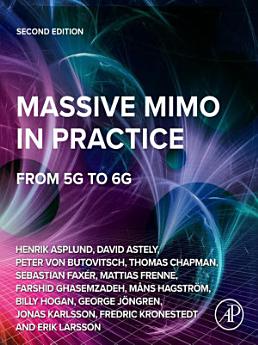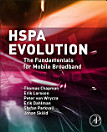Massive MIMO in Practice: From 5G to 6G, Edition 2
Henrik Asplund · George Jöngren · Jonas Karlsson · Fredric Kronestedt · Erik Larsson · David Astely · Peter von Butovitsch · Thomas Chapman · Sebastian Faxér · Mattias Frenne · Farshid Ghasemzadeh · Måns Hagström · Billy Hogan
May 2025 · Academic Press
Ebook
780
Pages
family_home
Eligible
info
reportRatings and reviews aren’t verified Learn More
About this ebook
Massive MIMO in Practice: From 5G/5G-Advanced to 6G (2nd edition of the previously titled Advanced Antenna Systems for 5G Network Deployments: Bridging the Gap between Theory and Practice) provides a theoretical introduction to Massive MIMO as well as presenting how it can meet network performance requirements for commercial deployment.Features include: A thorough understanding of: - Array antennas and how they can be used for beamforming, null-forming and support for MIMO features - Massive MIMO features and how they work, with a particular focus on mobile networks and the specifics relevant for mobile network operation, e.g. characteristics of the radio channel in different environment and how Massive MIMO solutions adapt to these - A detailed walk-through of the 3GPP physical layer support for Massive MIMO solutions, the background for this support and how it can be used in mobile networks - Explanations of what performance can be achieved in commercially deployed mobile networks for: different antenna configurations; different Massive MIMO features; different network deployment environments - An introduction to millimeter Wave solutions with a focus on the specifics of wave propagation and the corresponding technology solutions - Regulatory aspects which are new and specific to Massive MIMO operation - Product architecture and implementation aspects that provide cost efficient and flexible operation New to this edition: More detail on the practical use of Massive MIMO in commercial mobile networks, specifically how to choose solutions, including antenna configuration and suitable Massive MIMO features, for cost efficient operation depending on traffic and environmental conditions - A new chapter on how to put the complete Massive MIMO solution together: hardware solutions, features and use of spectrum - Outlines promising Massive MIMO solutions to be deployed in the future - Inclusion of 3GPP's Rel. 17 and Rel. 18 updates - Recent regulatory issues of high general interest - Practical aspects of network planning, deployment and operation - Examples of other applications of Massive MIMO: satellites, drones and WiFi - Outlines the path Massive MIMO can play to achieving 6G - Combines an explanation of the theory with a presentation of the practical issues around deployment - Includes details of 3GPP's Releases 17 and 18 - Thorough update and restructuring with more of a practical focus - Outlines the path Massive MIMO can play to achieving 6G
About the author
Henrik Asplund received his M.Sc. degree from Uppsala University, Sweden, in 1996 and joined Ericsson Research, Stockholm, Sweden, in the same year. Since then he has been working in the field of antennas and propagation supporting pre-development and standardization of all major wireless technologies from 2G to 5G. His current research interests include antenna techniques, radio channel measurements and modelling, and deployment options for 5G including higher frequencies.George Jöngren is currently an expert in adaptive multi-antenna technologies at Ericsson. Starting with his Ph.D. studies in 1999, he has two decades of experience working with state-of-the-art techniques in the multi-antenna field. He joined Ericsson in 2005 and has over the years had various roles, including working for eight years as a 3GPP delegate driving Ericsson's efforts on physical layer multi-antenna standardization. George Jöngren holds a Ph.D in signal processing and an M.Sc. in Electrical engineering from the Royal Institute of Technology, Stockholm, Sweden.Jonas Karlsson joined Ericsson in 1993. Since then he has held various technical and leader positions in Ericsson covering both radio access research and system management in product development. He is currently an Expert in Multi Antenna Systems at Development Unit Networks. He holds an M.Sc. in electrical engineering and engineering physics from Linköping University, Sweden, and a Ph.D. in electrical engineering from the University of Tokyo, Japan.Fredric Kronestedt joined Ericsson in 1993 to work on RAN research. Since then he has taken on many different roles, including system design and system management. He currently serves as Expert, Radio Network Deployment Strategies, at Development Unit Networks, where he focuses on radio network deployment and evolution aspects for 4G and 5G. Kronestedt holds an M.Sc. in electrical engineering from KTH Royal Institute of Technology, Stockholm, Sweden.Erik Larsson joined Ericsson in 2005. He is currently a researcher working with concept development and network performance for NR with a focus on advanced antenna systems. He holds both an M.Sc. in engineering physics and a Ph.D. in electrical engineering, specializing in signal processing, from Uppsala University, Sweden.David Astely is currently a Principal Researcher with Ericsson Research in the radio area. He received his Ph.D. in signal processing from KTH Royal Institute of Technology in 1999 and has been with Ericsson since 2001, where he has held various positions in both research and product development.Peter von Butovitsch joined Ericsson in 1994 and currently serves as Technology Manager at Systems & Technology. He has held various positions at Ericsson Research and in RAN system design over the years, and from 1999 to 2014 he worked for Ericsson in Japan and China. He holds both an M.Sc. in engineering physics and a Ph.D. in signal processing from KTH, Royal Institute of Technology in Stockholm, Sweden. In 2016, he earned an MBA from Leicester University in the UK. Peter von Butovitsch has served as the driver and main editor throughout the development of this book.Thomas Chapman is currently working within the radio access and standardization team within the Standards and Technology group at Ericsson. He has been contributing into 3GPP standardisation since 2000 to the whole portfolio of 3GPP technologies including UTRA TDD, WCDMA, HSPA, LTE and NR, and has been deeply involved in concept evaluation and standardization of AAS in RAN4. He holds an MSc (1996) and PhD (2000) in electronic engineering and signal processing from the University of Manchester, UK.
Rate this ebook
Tell us what you think.
Reading information
Smartphones and tablets
Install the Google Play Books app for Android and iPad/iPhone. It syncs automatically with your account and allows you to read online or offline wherever you are.
Laptops and computers
You can listen to audiobooks purchased on Google Play using your computer's web browser.
eReaders and other devices
To read on e-ink devices like Kobo eReaders, you'll need to download a file and transfer it to your device. Follow the detailed Help Center instructions to transfer the files to supported eReaders.




